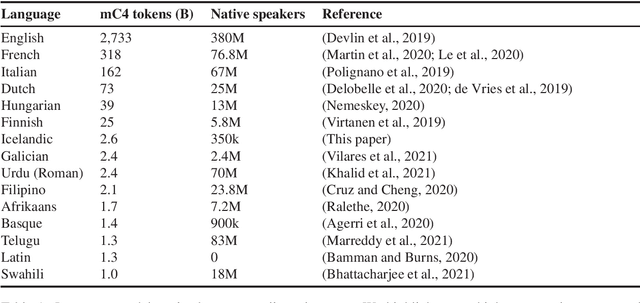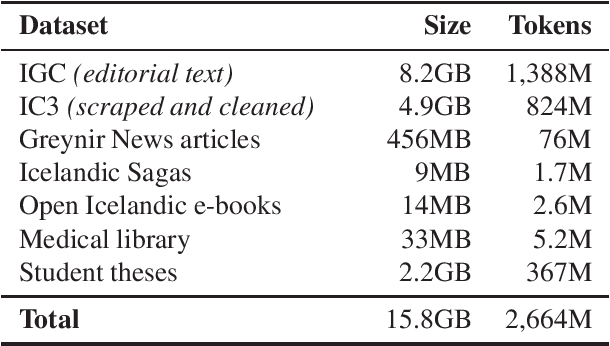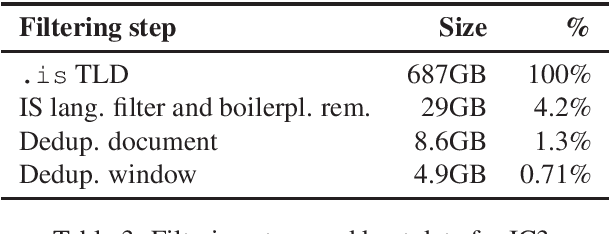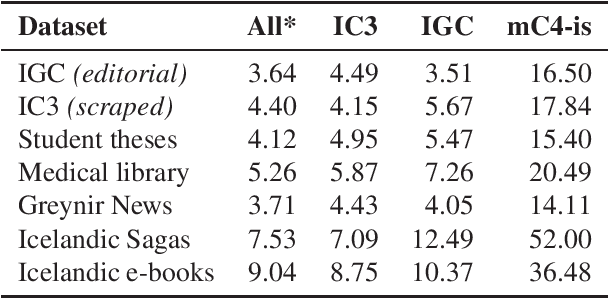Svanhvít Lilja Ingólfsdóttir
Byte-Level Grammatical Error Correction Using Synthetic and Curated Corpora
May 29, 2023Abstract:Grammatical error correction (GEC) is the task of correcting typos, spelling, punctuation and grammatical issues in text. Approaching the problem as a sequence-to-sequence task, we compare the use of a common subword unit vocabulary and byte-level encoding. Initial synthetic training data is created using an error-generating pipeline, and used for finetuning two subword-level models and one byte-level model. Models are then finetuned further on hand-corrected error corpora, including texts written by children, university students, dyslexic and second-language writers, and evaluated over different error types and origins. We show that a byte-level model enables higher correction quality than a subword approach, not only for simple spelling errors, but also for more complex semantic, stylistic and grammatical issues. In particular, initial training on synthetic corpora followed by finetuning on a relatively small parallel corpus of real-world errors helps the byte-level model correct a wide range of commonly occurring errors. Our experiments are run for the Icelandic language but should hold for other similar languages, particularly morphologically rich ones.
A Warm Start and a Clean Crawled Corpus -- A Recipe for Good Language Models
Jan 18, 2022



Abstract:We train several language models for Icelandic, including IceBERT, that achieve state-of-the-art performance in a variety of downstream tasks, including part-of-speech tagging, named entity recognition, grammatical error detection and constituency parsing. To train the models we introduce a new corpus of Icelandic text, the Icelandic Common Crawl Corpus (IC3), a collection of high quality texts found online by targeting the Icelandic top-level-domain (TLD). Several other public data sources are also collected for a total of 16GB of Icelandic text. To enhance the evaluation of model performance and to raise the bar in baselines for Icelandic, we translate and adapt the WinoGrande dataset for co-reference resolution. Through these efforts we demonstrate that a properly cleaned crawled corpus is sufficient to achieve state-of-the-art results in NLP applications for low to medium resource languages, by comparison with models trained on a curated corpus. We further show that initializing models using existing multilingual models can lead to state-of-the-art results for some downstream tasks.
Nefnir: A high accuracy lemmatizer for Icelandic
Jul 27, 2019
Abstract:Lemmatization, finding the basic morphological form of a word in a corpus, is an important step in many natural language processing tasks when working with morphologically rich languages. We describe and evaluate Nefnir, a new open source lemmatizer for Icelandic. Nefnir uses suffix substitution rules, derived from a large morphological database, to lemmatize tagged text. Evaluation shows that for correctly tagged text, Nefnir obtains an accuracy of 99.55%, and for text tagged with a PoS tagger, the accuracy obtained is 96.88%.
 Add to Chrome
Add to Chrome Add to Firefox
Add to Firefox Add to Edge
Add to Edge